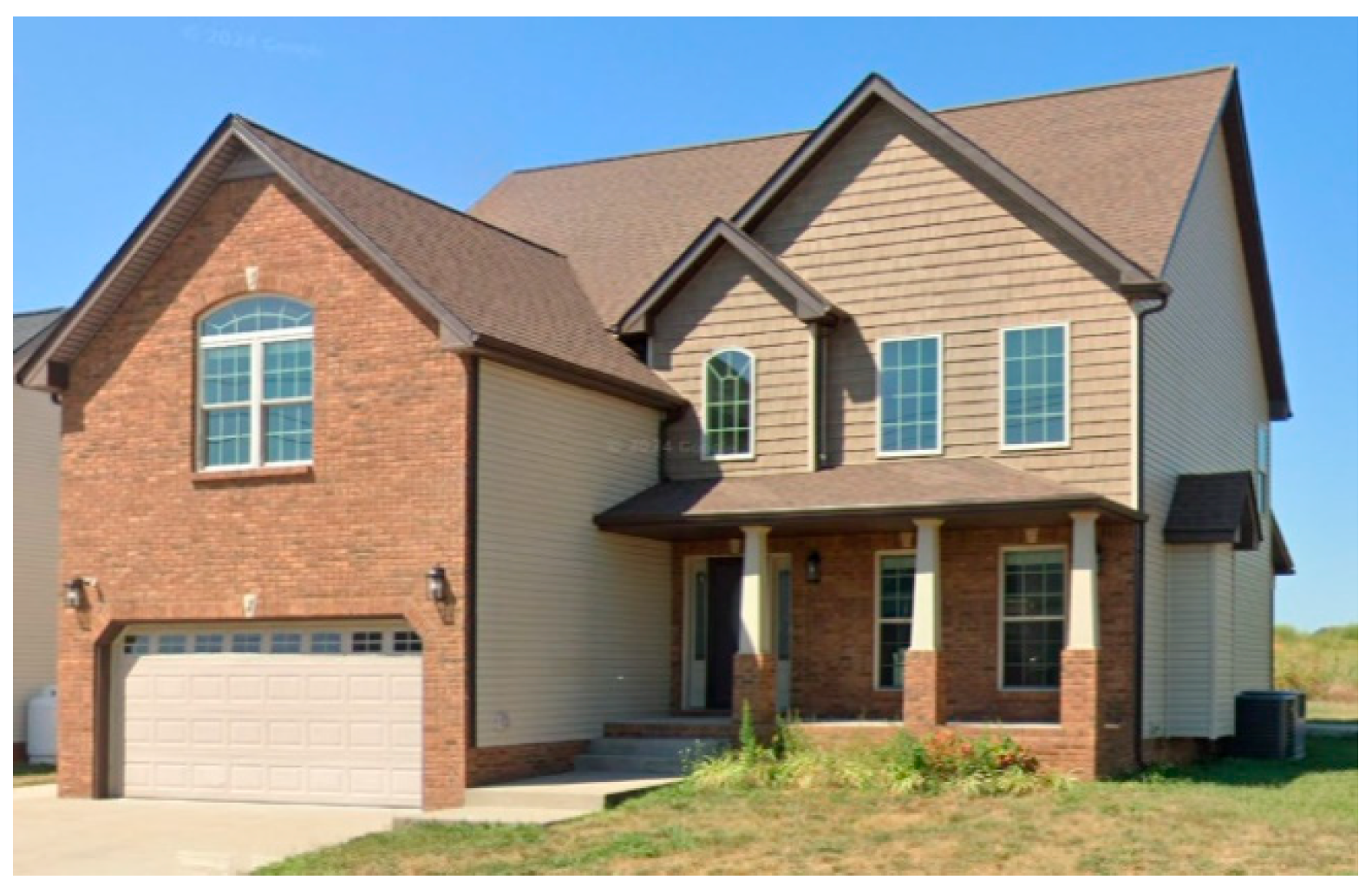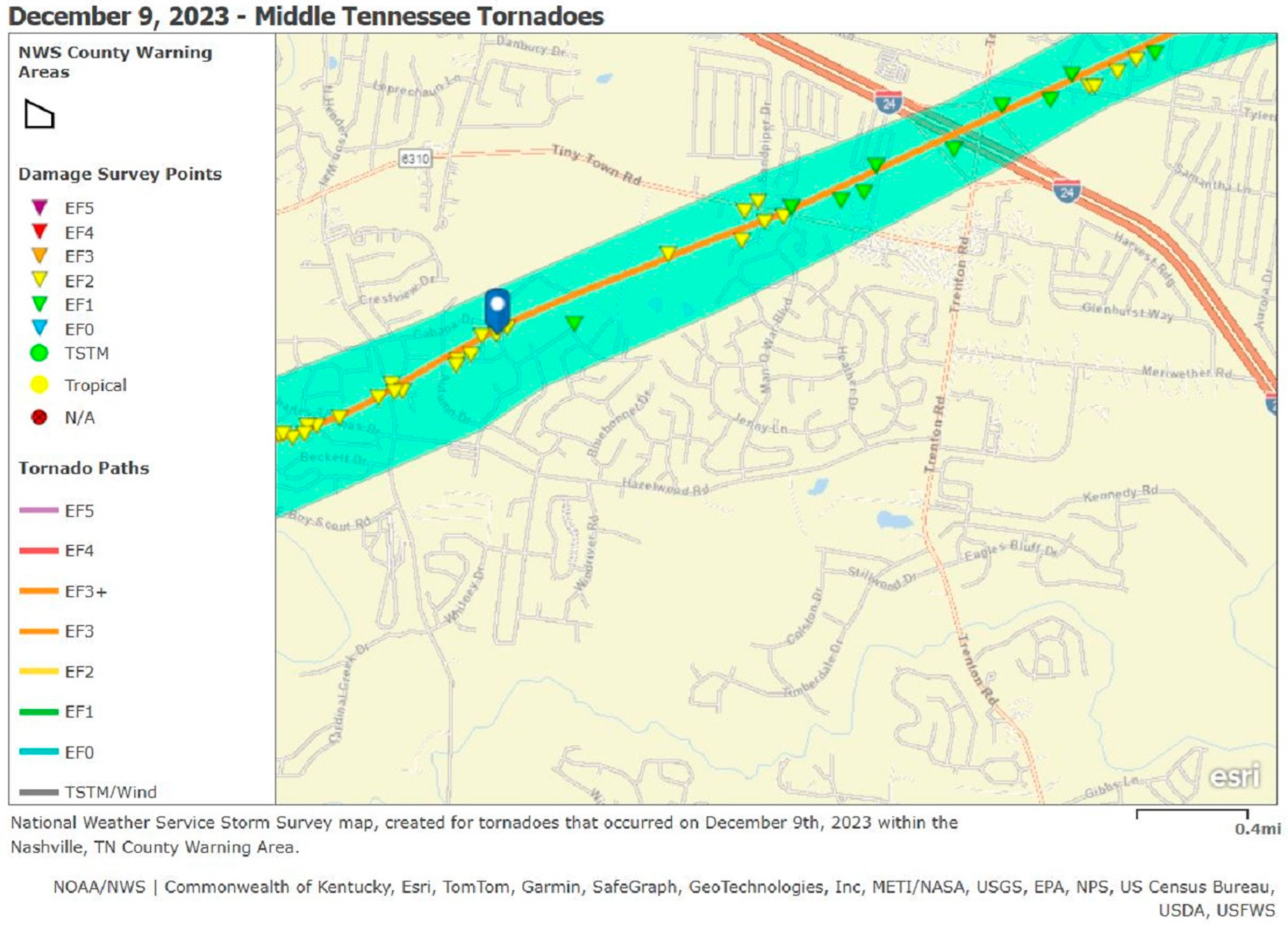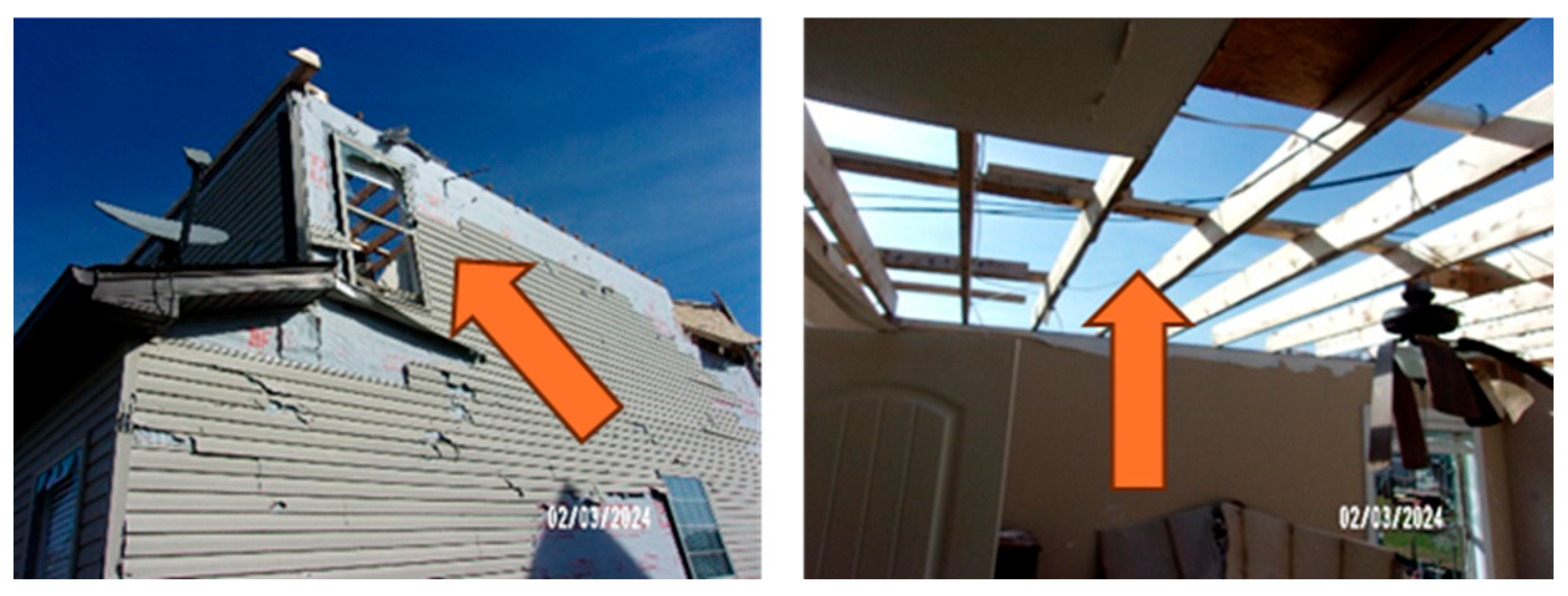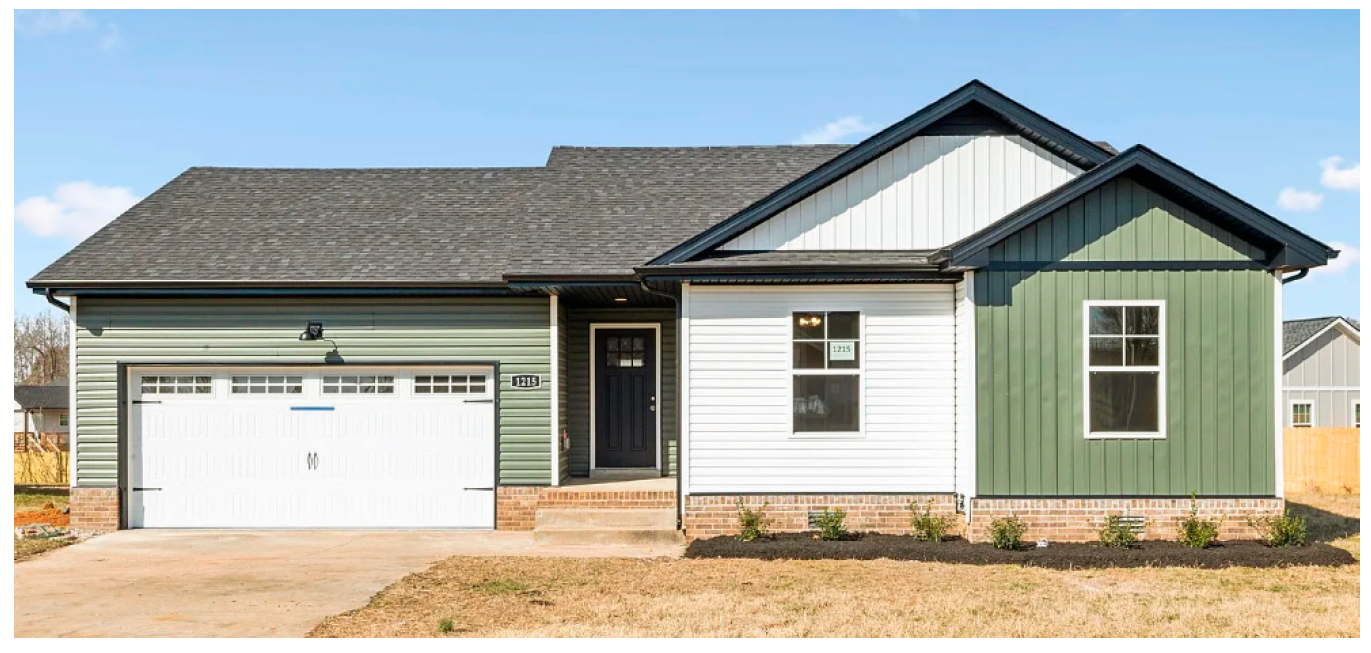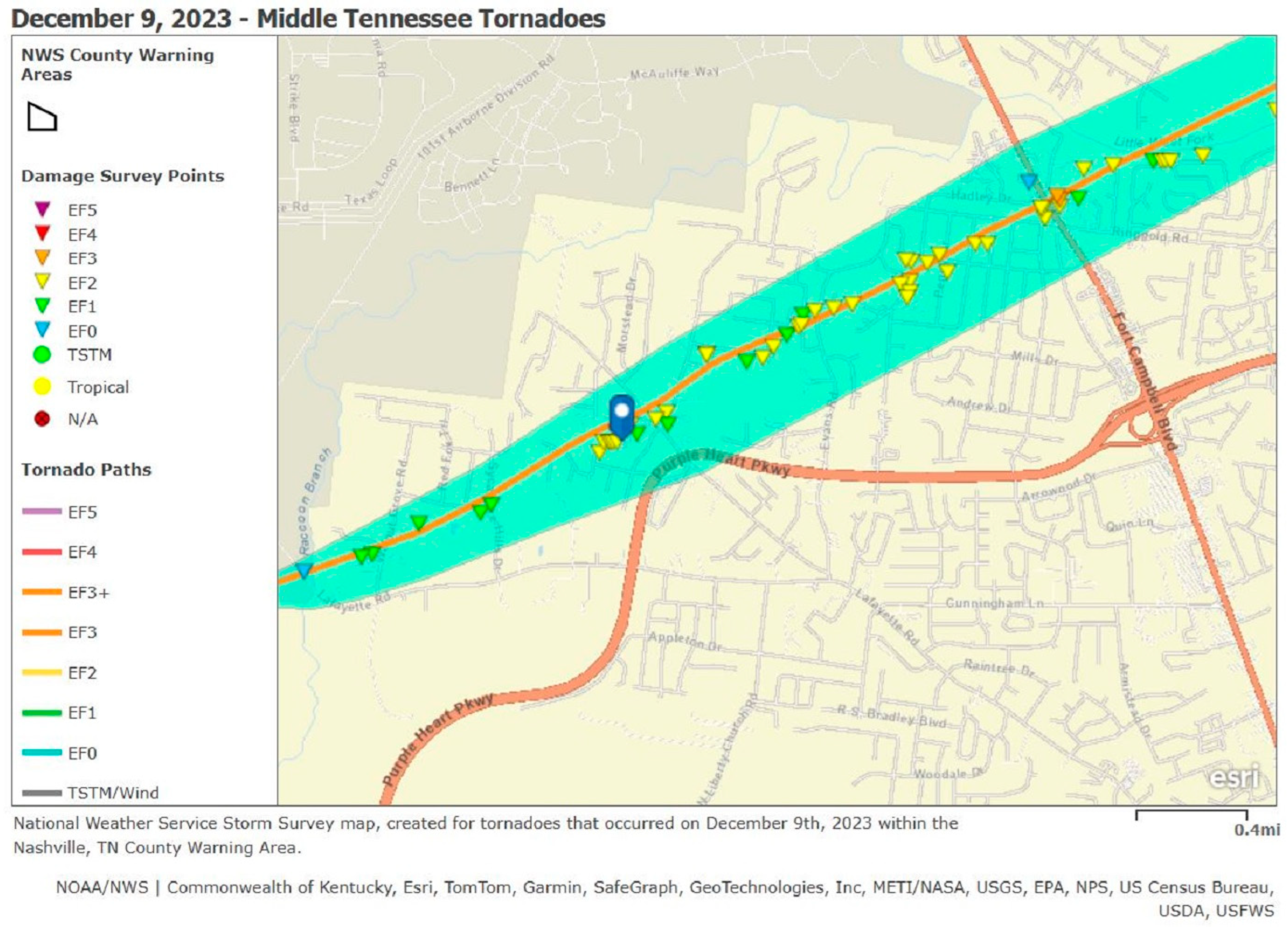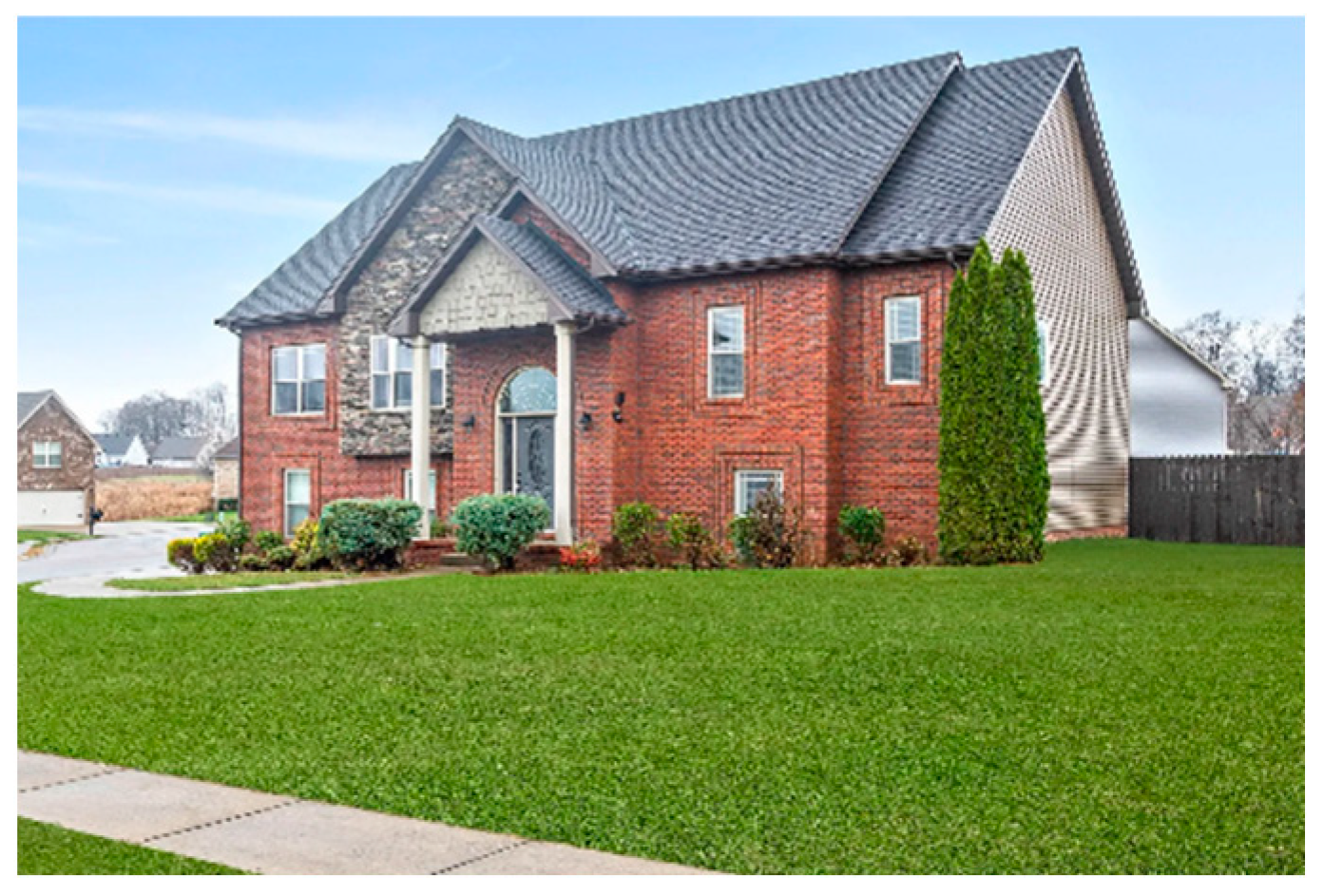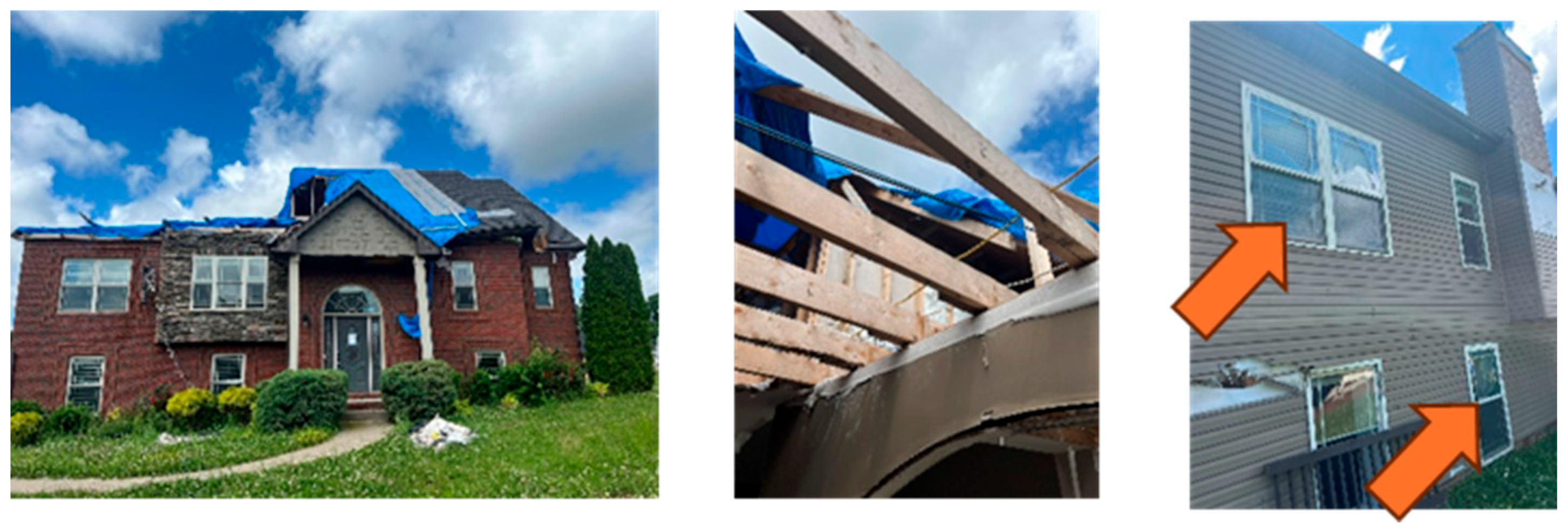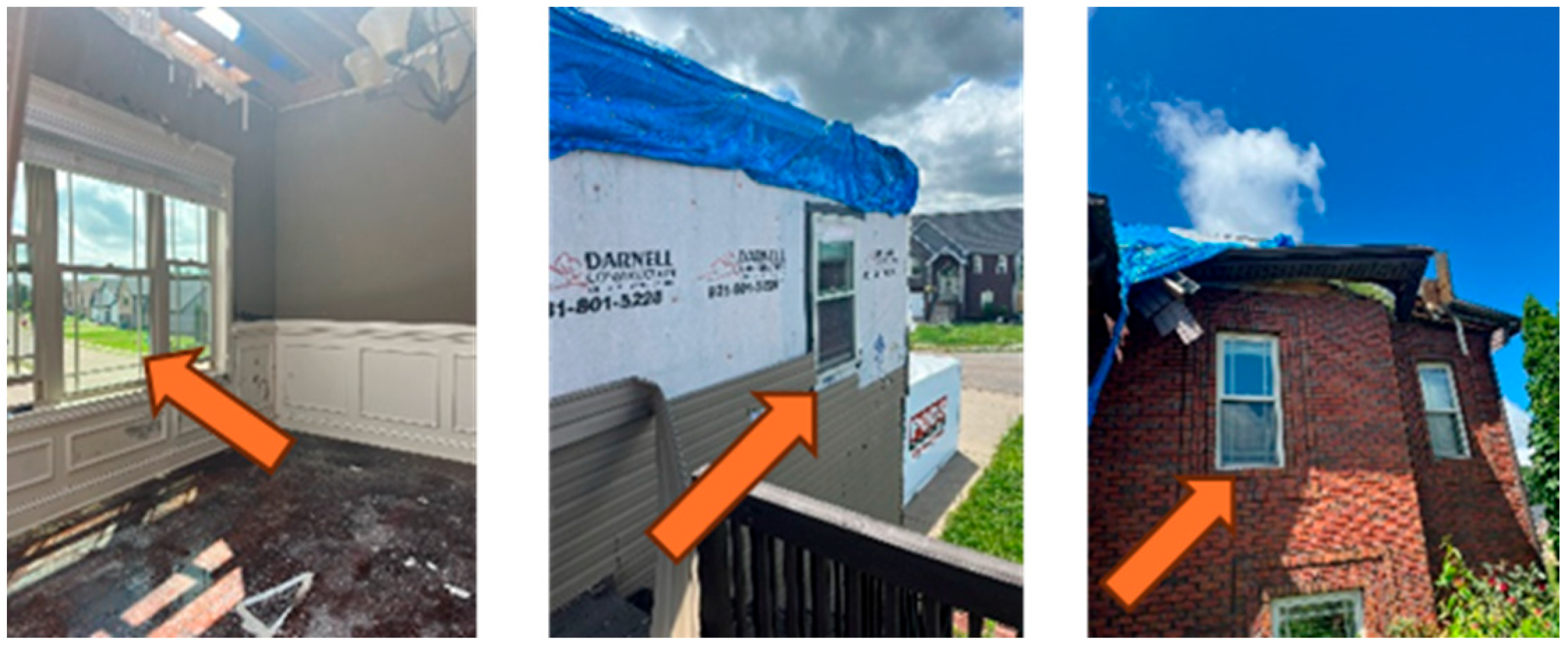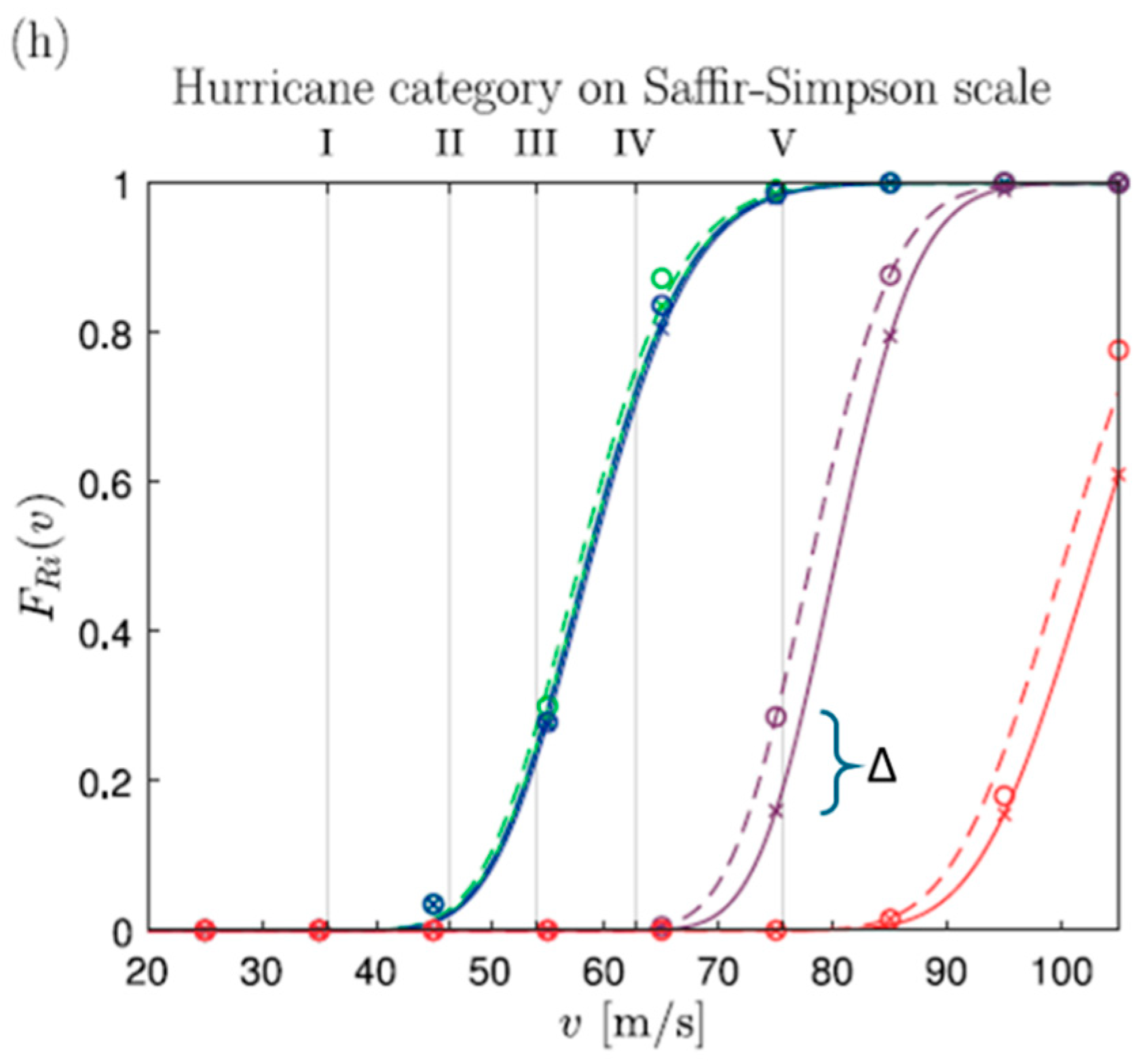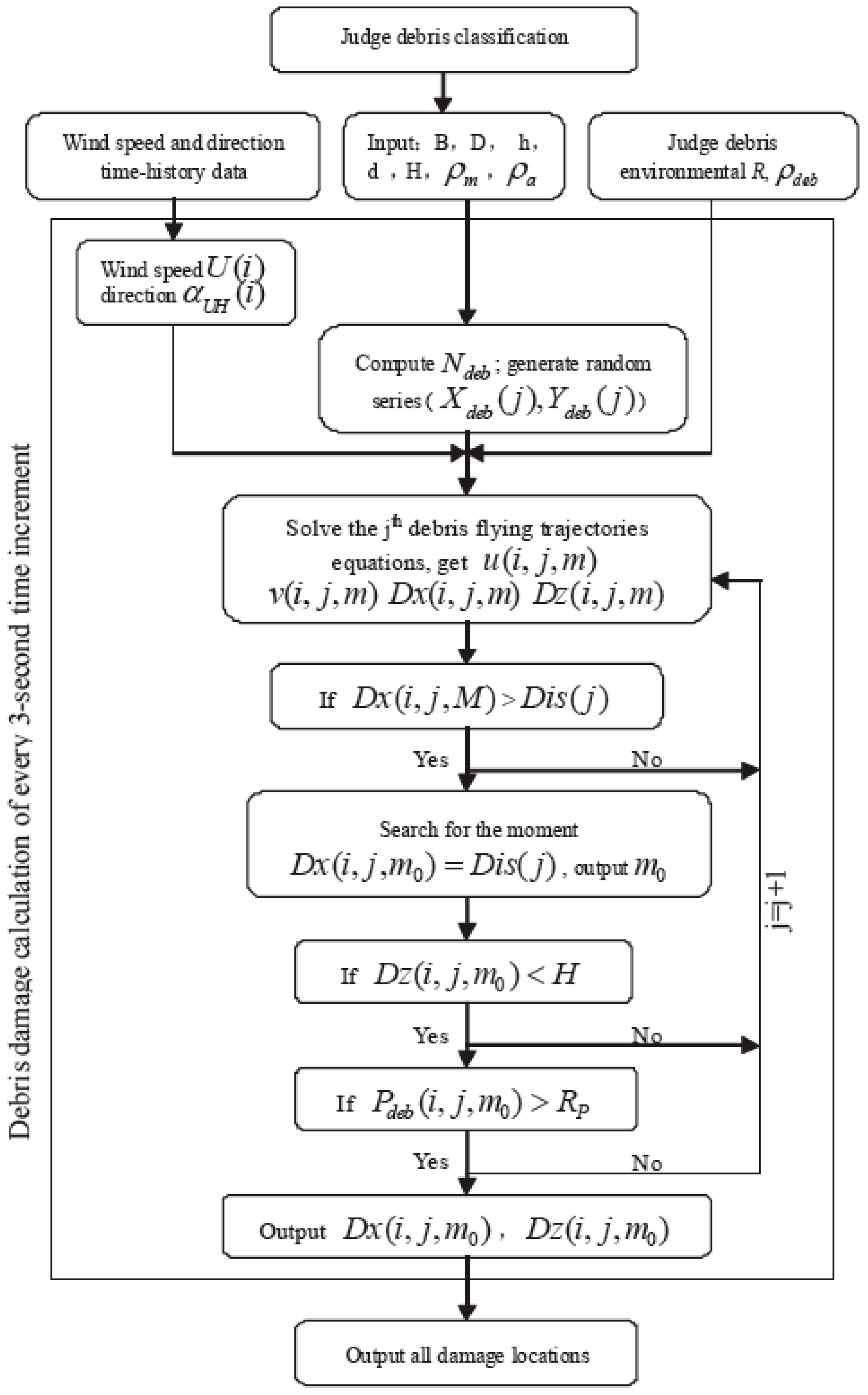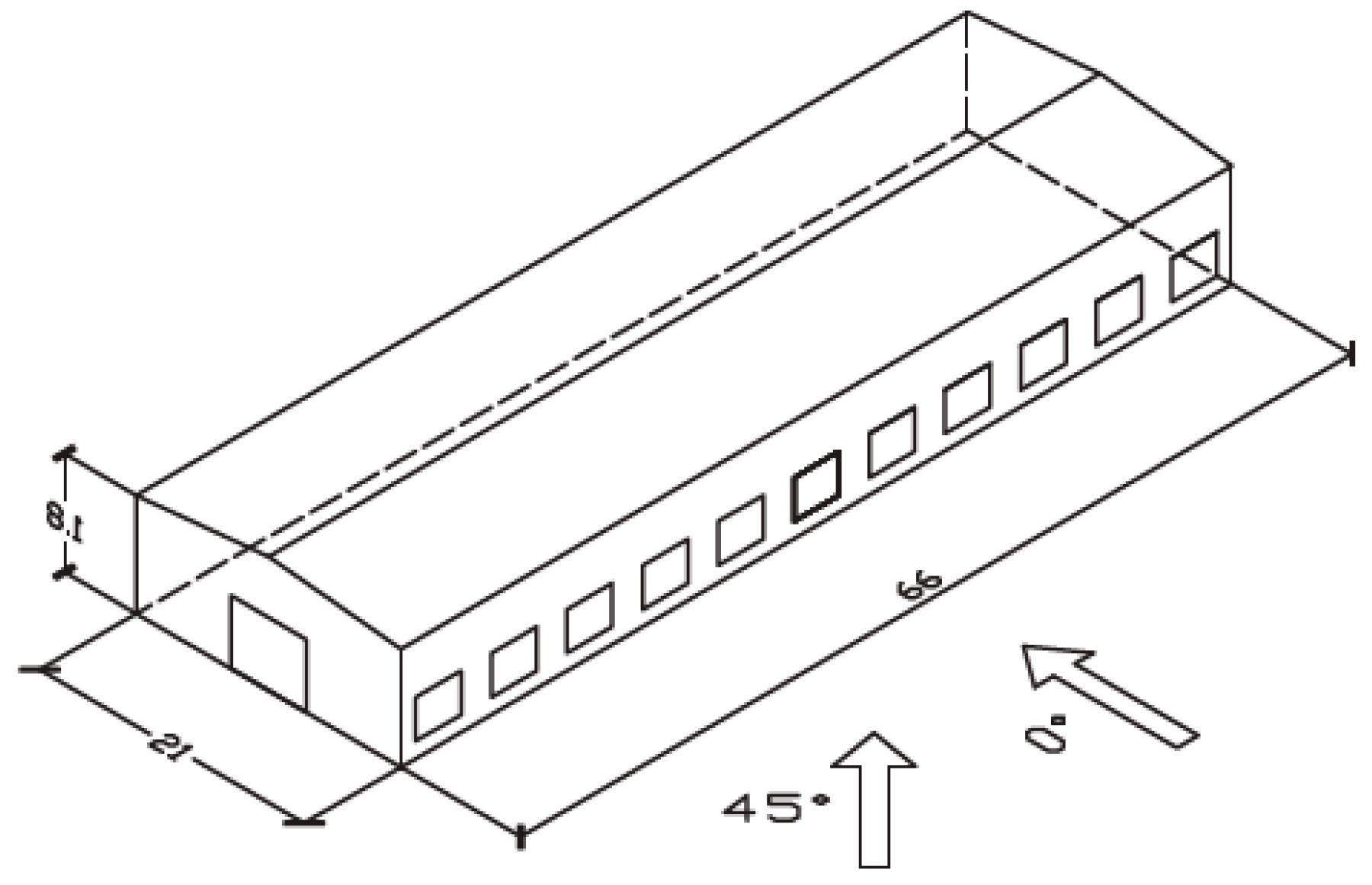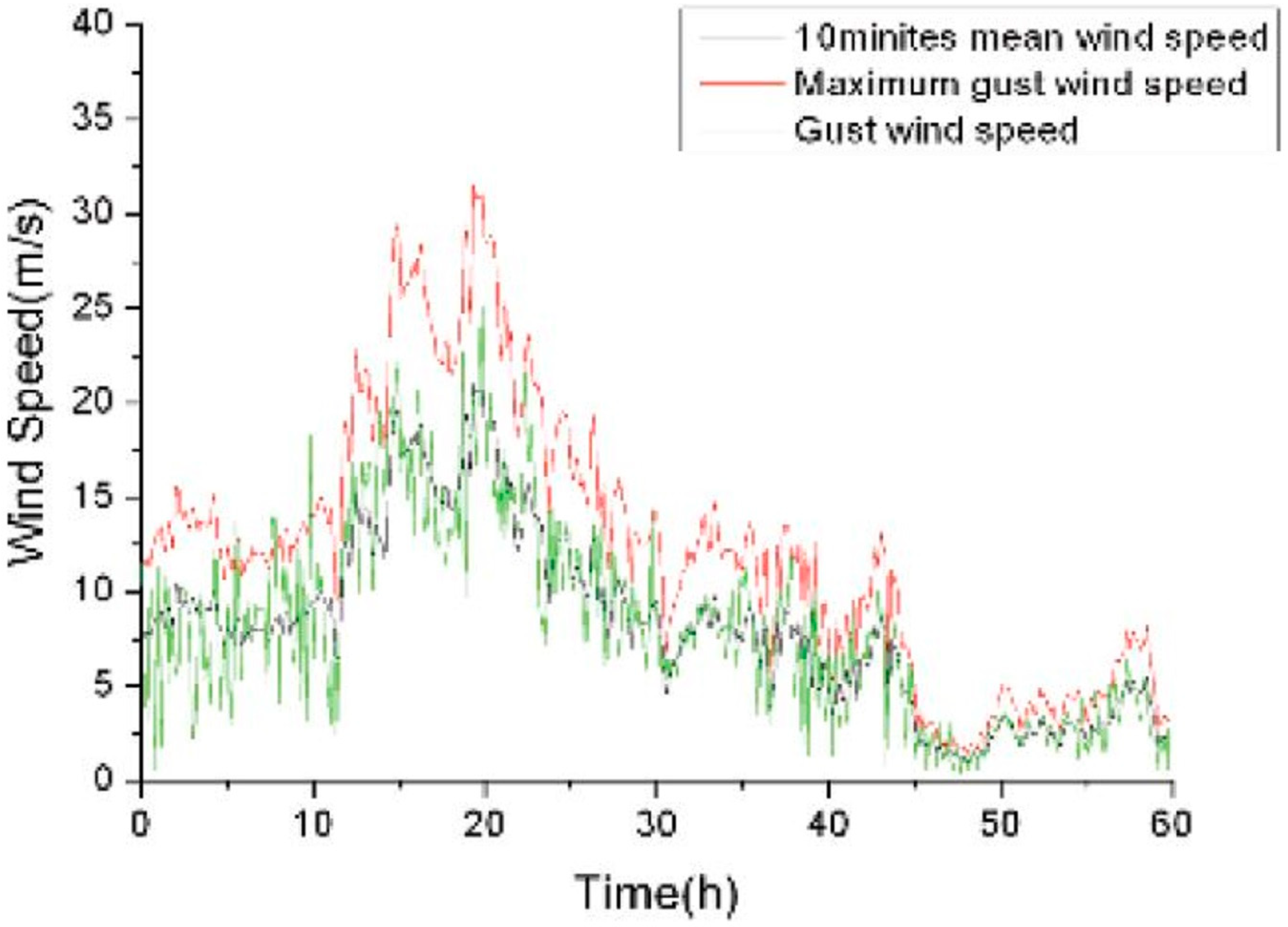In the current ASCE 7 wind load calculation method, enclosure classification is determined based on the area of openings in the building envelope, without considering whether these openings remain intact or are breached during an extreme wind event. Consequently, Enclosed buildings use the lower internal pressure coefficient (GCpi = ±0.18), whereas Partially Enclosed buildings use GCpi = ±0.55.
2.1. Real-World Case Studies
The author conducted detailed structural inspections following a tornado event in Clarksville, Tennessee (December 2023), to assess the extent of building damage. At the time of these investigations, the author was a licensed Professional Engineer (PE) in the states of Tennessee and Kentucky.
All the investigated buildings were wood-frame residential structures classified as low-rise buildings. According to ASCE 7, the enclosure classification for all the buildings was Enclosed, which corresponds to an expected lower internal pressure coefficient per design compared to the Partially Enclosed classification. The impact of windborne debris was particularly evident in the damage to windows, garage doors, exterior walls, and roof assemblies. A consistent pattern of damage included one or two blown-out windows on one side of the building and partial to total roof assembly failure near the affected area. The buildings were deemed unsafe to occupy but were considered repairable.
The following case studies examine three buildings inspected for both structural and nonstructural damage following the tornado events. Wind speed data, obtained from the National Weather Service storm reports, correspond to the same tornado event at the locations of the buildings are used as reference values for comparison.
A structural inspection was conducted on 3 February 2024 to assess a residential building located in Clarksville, Tennessee (
Figure 1). The subject structure is a two-story, wood-framed residential house, constructed in 2012 (per Realtor.com records), with no basement.
Figure 1 illustrates the building prior to the tornado damage.
As a result of the tornado event in the Clarksville area on 9 December 2023, the residential building and its surrounding area sustained wind damage.
Figure 2 displays the tornado path and illustrates the location of the building in relation to the path. The building is located within the tornado’s estimated damage area of EF2.
The entire roof structure assembly, including roof trusses, rafters, and roof decking, was completely displaced due to uplift forces generated by tornado winds. While most of the ceiling joists remain in place, several have sustained damage. Only one room with a vaulted ceiling retains its roof rafters; however, portions of the roof decking are missing in that area. The exterior wall sidings have also been damaged and require full replacement. As a result of the tensile forces exerted by the uplifted roof rafters, the top plates may need to be repaired or replaced. No signs of pull-out or failure of wall anchors or hold-downs were observed, and the foundation system, including the CMU stem walls, showed no evidence of cracking or structural damage. The floor joists and CMU piers in the crawlspace were found to be intact, although some water intrusion was noted in the area. The posts supporting both the front and back porches were damaged and displaced. All wall and floor insulation has been saturated due to water intrusion and must be replaced. In addition, all floor carpeting should be removed down to the subfloor and replaced.
A key observation was that only a couple of windows located on the upper level windward exterior wall were blown-out (
Figure 3). In contrast, most other windows across the building envelope remained intact (
Figure 4).
Notably, in the vicinity of the blown-out windows, roof panels were uplifted and completely detached, indicating significant internal pressurization following the initial window failure (
Figure 4). This suggests that roof panel uplift occurred primarily in areas near the failed windows, while the remainder of the roof—associated with intact windows—sustained comparatively less damage.
Similar to Case 1, the evidence suggests that roof assembly failure was a consequence of increased internal pressure following localized garage door blowout, rather than occurring simultaneously with or prior to window failure elsewhere on the structure.
A structural inspection was conducted on 20 April 2024, on a residential building located in Clarksville, Tennessee (
Figure 5). The subject building is a one-story, wood-framed residential structure with no basement, constructed in 1999 according to Zillow.com records.
Figure 5 illustrates the building post-repair following the tornado event.
The house was hit by an EF2-level tornado on 9 December 2023 (see the tornado path below in
Figure 6). During the structural inspection of the building, several significant damages were identified as a result of tornado-induced wind loading (
Figure 7).
The structural frame exhibited extensive damage, including a completely dislodged garage door and wall on the west side of the house, damaged ceiling joists and panels primarily affecting the western portion of the structure, a tilted and partially dislodged exterior wall on the east side, and widespread misalignment of interior stud walls and top plates throughout the building. The concrete masonry unit (CMU) stem walls on the north and west sides also displayed substantial cracking and separation between and within the blocks. The exterior wall on the east side was found to be severely compromised, having detached from both the roof rafters and the top plates, with a large portion of the gable-end of the roof blown off. In addition, the top plates on the north side of the house exhibited significant separation from the roof rafters above the exterior wall, indicating a loss of structural integrity at those connections.
A key observation was that, while the windward garage door and the adjacent wall were completely blown-out, the windows on the remaining portions of the building envelope remained mostly intact (
Figure 8). However, a large section of the exterior wall and the adjacent roof framing sustained significant damage due to the increase in internal pressure following the initial breach at the garage door.
Similar to Case 1, the evidence suggests that gable-end panel failure was a consequence of increased internal pressure following localized garage door blowout, rather than occurring simultaneously with or prior to window failure elsewhere on the structure.
A structural inspection was conducted on 15 May 2024 to evaluate a residential building located in Clarksville, Tennessee (
Figure 9). The subject property is a two-story, wood-framed house with no basement, constructed in 2014 according to Zillow.com records.
As a result of the tornado event in the Clarksville area on 9 December 2023, the residential building and its surrounding area sustained wind damage.
Figure 10 displays the tornado path with the location of the building in relation to the path. The building is located within the tornado’s estimated damage area of EF2.
The inspection revealed that most of the roof structure, including trusses, rafters, and roof decking, had been displaced by wind uplift forces, with only a portion of the roof elements near the attic access remaining intact (
Figure 11).
Several of the ceiling joists were still in place, though some showed signs of damage. The exterior wall sidings sustained notable damage and required full replacement. Tension forces transferred from the roof rafters during uplift likely compromised the top plates, which may require repair or replacement. However, no displacement of wall anchors or hold-downs was observed, and the foundation and CMU stem walls showed no signs of cracking or structural damage. A post on the front porch was found to be damaged and misaligned. Despite the extent of damage, the walls, floors, window frames, and door frames were found to be level and plumb, with no significant permanent deformation detected in the wall framing.
Despite the significant damage to the roof assembly caused by increased internal pressure and external suction, and although the windows on one side of the building were mostly blown-out, the windows on the rest of the building envelope remained largely intact (
Figure 12).
A similar failure pattern is observed in this case study: a couple of windows were blown-out due to wind pressure and windborne debris, followed by the uplift failure of roof panels as a result of increased internal pressure.
Based on the damage inspections conducted on the three building case studies, a consistent pattern emerged: one or two blown-out windows caused by windborne debris on one side of the building, accompanied by partial to total roof assembly failure near the affected area, while the remaining windows and doors on the rest of the building envelope remained intact. This indicates that the actual enclosure classification should be considered Partially Enclosed rather than Enclosed. Accordingly, for buildings exposed to windborne debris, using the Partially Enclosed internal pressure coefficient (GCpi = ±0.55), rather than the Enclosed value (GCpi = ±0.18), better aligns with real-world performance and should be used in design. Importantly, the internal pressure coefficients associated with each enclosure category are adopted directly from ASCE 7 without modification; our proposal alters only the classification decision, not the coefficient values.
To validate the failure mechanism of the roof panels adjacent to blown-out windows, as observed in the case studies, here we calculate the design uplift force for the roof panels and compare that with window glazing in the balance of the building envelope to see which would fail first.
According to the International Residential Code (IRC 2018) [
14], Table R602.3(1), the prescribed fastening schedule for roof sheathing up to 1 inch thick requires 8d common nails spaced at 6 inches on edges and 12 inches at intermediate supports. Per Table 12.2C of the National Design Specification (NDS) for Wood Construction (2018) [
15], the maximum withdrawal capacity of an 8d common nail is 32 pounds.
Assuming a common rafter spacing of 16 inches, each nail at intermediate supports has a tributary area of 1.3 square feet (16″ × 12″). With the withdrawal capacity of an 8d common nail, this allows the roof panel with a single nail tributary area to resist up to 25 pounds per square foot in withdrawal for common lumber species such as Hem Fir or Douglas Fir, both with specific gravities of up to 0.5. These species are widely used in wood-frame construction. However, increased rafter spacing enlarges the tributary area per nail, resulting in greater withdrawal demand on each fastener and potentially reducing the allowable wind uplift resistance unless additional fastening is provided.
In comparison, a typical double-pane window with 1/8-inch glass in a vinyl frame is often rated for approximately ±30 psf of wind pressure
On the other hand, according to ASCE 7, the external wind pressure coefficient for the windward roof surface at a 20-degree slope is approximately −0.69, whereas the leeward external pressure coefficient for exterior walls with windows is −0.48. For 30–45-degree roof angles, the corresponding coefficients are −0.43 for the roof and −0.43 for the walls.
This indicates that the net external suction (uplift) on the roof panels is greater than the pressure acting on exterior walls with windows. As a result, roof panel failure due to wind uplift is more probable than window blowout, especially when accounting for both internal and external pressure coefficients acting together under wind load conditions. This failure mechanism aligns with post-event damage surveys, which commonly show roof uplift damage occurring before window blowout on the remaining portions of buildings.
2.2. Analytical Validation
Beyond the real-world case studies, the author applied two analytical investigations of windborne debris effects to corroborate the field observations. The first indicates that the probability of building damage increases in the presence of debris relative to the no-debris case. The second shows the likelihood of debris-induced window failure, supporting the classification of affected structures as Partially Enclosed under ASCE 7.
The first study is by Ahmed Abdelhady, Spence, and McCormick (2018) [
16], titled “Risk and fragility assessment of residential wooden buildings subject to hurricane winds, investigating the impact of debris on buildings in a community”. This study examined the effect of debris under different building density conditions—comparing cases where a building was surrounded by densely packed structures versus a building located in a more open, dispersed community. The findings indicated that under the same wind speed conditions, the likelihood of higher damage due to debris ranged from 5% to 20%, specifically in higher damage states.
Figure 13 illustrates the fragility functions of low-rise wood-frame buildings subjected to wind events, with and without windborne debris, for a gable-roof building archetype.
The fragility functions were derived for three different construction types and three floor aspect ratios (FARs). The curves represent both simulation results (S) and fitted lognormal cumulative distribution functions (CDFs). As shown, in most cases, the presence of debris significantly increases the probability of damage.
Taking construction case (7) as an example,
Figure 14 illustrates the difference in damage probability with and without the effect of windborne debris impact. This difference is about a 10% difference in probability of damage, denoted as Δ, and is shown for a representative wind hazard intensity of 75 m per second.
According to the observations above, the study by Ahmed Abdelhady, Spence, and McCormick (2018) [
16] provides analytical evidence supporting the conclusion that windborne debris increases the probability of wind-induced damage in residential buildings. This emphasizes the importance of incorporating the effect of windborne debris in wind design calculations for buildings.
The author applied the study by Song and Ou (2009) [
4], who performed a numerical analysis of windborne debris damage to buildings. They adopted analytical equations for debris flying trajectories from an earlier study by Tachikawa (1983) [
3] to estimate the total number of debris items in relation to the area of the debris source region, the length of the structure, the radius of the debris region, the wind direction angle, and the distribution density of debris. Furthermore, they proposed trajectory equations that incorporate debris mass, reference length, reference area, and mass moment of inertia, along with kinematic variables such as displacement, velocity, angular rotation, and time. Environmental factors, including wind speed, air density, gravitational acceleration, and the relative wind angle, were also considered, as well as aerodynamic force coefficients for drag, lift, and moment.
- (a)
Plate-like debris flying trajectories:
In this study, the governing parameters are defined as follows: m represents the debris mass; l is the reference length, taken along the wind direction (for example, the along-wind dimension of a plate or rod); A denotes the reference debris area, typically assumed as the maximum projected face area; and Iₘ is the mass moment of inertia of the debris. The displacement components are given by x (horizontal) and z (vertical), while θ indicates angular rotation. The velocity components include uₘ for horizontal velocity and vₘ for vertical velocity. Wind conditions are represented by U (wind speed) and ρₐ (air density). Aerodynamic effects are accounted for by the coefficients Cᴰ, Cᴸ, and Cᴹ, corresponding to drag, lift, and moment forces, respectively. The angle between the wind vector and the horizontal is denoted by β. Finally, g is the gravitational acceleration, and t is the time variable.
- (b)
Compact debris flying trajectories:
These formulations provide a framework for modeling debris generation and flight, enabling the assessment of impact risks to building envelopes during wind events (Song and Ou 2009) [
4]. Below is the flowchart illustrating the numerical analysis conducted by the authors to assess windborne damage to buildings (
Figure 15).
As an illustrative case, a lightweight steel structure with gabled frames was analyzed to demonstrate the process of estimating windborne debris damage (
Figure 16). The building included 11 uniformly distributed windows on both the windward and leeward walls, each measuring 3.0 m × 3.6 m. The schematic drawing of the structural dimensions and wind direction is shown in
Figure 16. The glazing consisted of 6 mm fully tempered monolithic glass with an estimated breakage threshold momentum of 0.1 kg·m/s (Behr et al. 1994) [
17]. Gravel was selected as the representative debris, with a debris region radius of 30 m, a distribution density of 2, diameters ranging from 5 to 15 mm (uniformly distributed), and a material density of 2000 kg/m
3.
Wind data from Typhoon Chanchu were used as the loading input. The original data were processed and adjusted to the average roof height of 8.625 m (from the reference 325 m). With a time interval of 10 min, the gust speed envelope was obtained by multiplying the mean wind speed by the gust factor. The resulting wind speed–time-history curves are presented in
Figure 17.
The numerical analysis showed that only 13.6% of windows were damaged during the 10 min storm period when gravel debris originated at 8 m above ground, while no damage occurred when debris was located at ground level. These results indicate a very low probability of all window openings being damaged during a severe windstorm. This finding supports the importance of considering the Partially Enclosed classification rather than assuming fully enclosed or fully open conditions.
